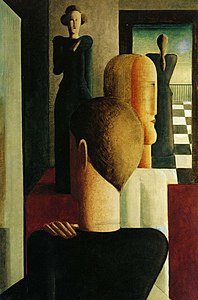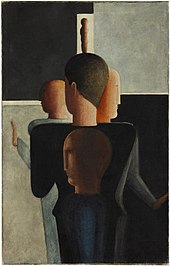Roman (or: five figures in space)

|
| Roman (or: five figures in space) |
|---|
| Oskar Schlemmer , 1925 |
| Oil on canvas |
| 97 × 62 cm |
| Kunstmuseum Basel , Basel |
Roman (or: Five Figures in Space) is the title of a painting by Oskar Schlemmer from 1925. It is also referred to several times as Four Figures in Space . The picture represents a key work of Schlemmer, as it was the first or one of the first works by the artist in museum possession.
The work was shown in the Munich exhibition “ Degenerate Art ”, which opened on July 19, 1937 in the Hofgartenarkaden.
position
On the occasion of the Stuttgart retrospective in 2014, Sven Behrisch located the artist both in the avant-garde and surprisingly and convincingly at the same time as classic: "[...] in works like Duo from 1930 or the Bauhaus staircase there is an order that is both geometric and sensual, both archaic and modern, that they acquire a rare quality: They become classic. ”This also applies to Roman works , which were written five or seven years before the works mentioned. Here, too, the painted figures are constructed like sculptures that are pushed together again and again "on accurately drawn surfaces to form a sculpture park of the new man". Two women, two men, painted overlapping and yet no interaction. At least three look in different directions, the fourth diagonally in the fourth. The severity of the composition corresponds to the lack of relationships in modern times. Only the concentric group is built even more strictly around the axis of symmetry , also created in 1925, also shown in 1937 in the exhibition Degenerate Art .
Provenance
In 1927 the work was acquired by director Ernst Gosebruch for the Folkwang Museum in Essen. In 1932, the painting was shown on loan at the New German Art exhibition in Oslo.
After the seizure of power by the Nazis in January 1933, the works were Schlemmer as " degenerate art classified" and eventually removed from all public collections. The work came into the possession of the Reich Ministry for Public Enlightenment and Propaganda and, like four other works by Schlemmer, was shown in the defamatory exhibition in Munich from July 1937. In 1938, the Berlin art dealer Karl Buchholz was commissioned to “recycle” the confiscated Schlemmer works.
The Basel Art Museum acquired a total of 21 works from the former German museum holdings. Six of these works were purchased directly from the Propaganda Ministry through the agency of Buchholz; in addition to the painting in question, these were Schlemmer's Frauentreppe and one work each by Max Beckmann , Lovis Corinth , Franz Marc and Emil Nolde . The two paintings by Schlemmer were purchased in 1939 with a special loan from the Basel government. A preliminary study for the painting (acquired in 1953) and a watercolor study on whitish tissue paper on the same subject (also acquired in 1953) can also be found in the museum's copper engraving cabinet.
Web links
- Kunstmuseum Basel , works by Oskar Schlemmer
- Five Figures in Space, Roman, 1925
- Oskar Schlemmer , with a description of the work
Individual evidence
- ↑ Sven Behrisch : The dolls of modernity. In: The time . 49, Hamburg 2014 ( zeit.de ).
- ↑ Mark Lörz: Modern German Art. Oslo, Copenhagen, Cologne 1932. Reconstruction and documentation, ibidem-Verlag 2012, ISBN 978-3-8382-5887-4 , p. 158 f.
- ^ "Degenerate Art", Schlemmer. opendatacity.github.io (PDF), accessed January 29, 2020.
- ↑ Gesa Jeuthe: The price development of German modernism in the national and international art market from 1925 to 1955. Walter de Gruyter 2014, page 117 (note 239).
- ^ Kunstmuseum Basel: First sketch for "Five Figures in Space, Roman", 1925 , accessed on June 30, 2020
- ^ Kunstmuseum Basel: Study for "Five Figures in Space, Roman", 1925 , accessed on June 30, 2020
